Battery technology has come a long way in recent years. Some types of batteries can last for up to 20 years.
But there’s a catch: The batteries must be stored properly or risk losing their charge, getting shorted, or having capacity permanently diminished.
This guide covers everything you need to know about storing batteries, including shelf life and long-term battery storage for power outages or disaster preparedness.
General Instructions for Storing Batteries
Regardless of type, there are some general rules for storing batteries.
Don’t Let Batteries Touch Each Other or Metal Objects
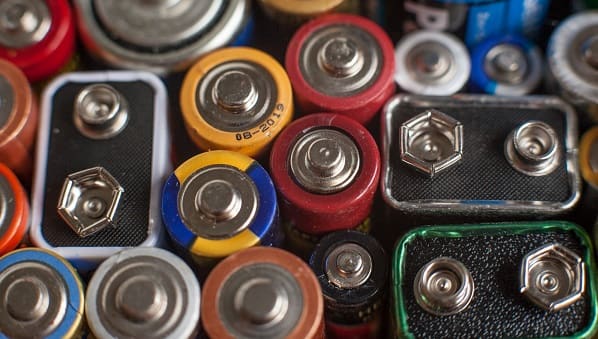
Got a bunch of batteries hanging out in a drawer? This is a very bad way to store batteries because their ends can touch each other. Or, there might be metal objects like paperclips or coins in the drawer.
If the batteries touch metal or each other, they could short. This could result in FIRE, BURNS, or even an EXPLOSION.
This is no joke. The London Fire Brigade even warns about it, saying they get called to 24 fires per week started by batteries, chargers, or cables.
Even if they don’t get hot, the metal could still affect the batteries’ polarity. So keep them neatly organized, so their ends don’t touch metal.
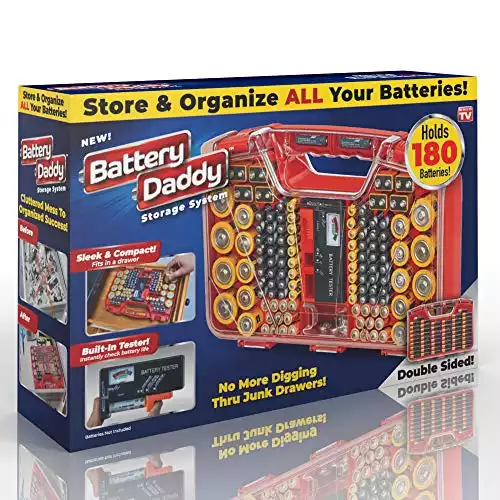 Ontel Battery Daddy
Ontel Battery Daddy
This is an excellent storage option to keep batteries neatly organized so their ends don’t touch metal or each other.
Keep Batteries Cool
Heat is terrible for battery chemistry. Generally, most batteries need to be kept around room temperature (50-70F).
It varies by battery type, but the self-discharge rate generally doubles for every 18F increase in temperature. In other words, the battery will drain faster even when not in use.
You might think that this doesn’t matter with rechargeables – you can recharge them to regain the lost capacity, right? Wrong. Heat can permanently affect how much charge the battery can hold.
But Don’t Freeze or Refrigerate Batteries
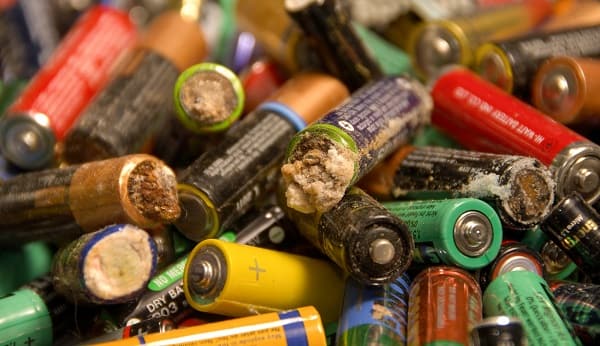
Contrary to common belief, you should NOT store batteries in the freezer. The condensation can cause the batteries to corrode and permanently ruin them.
Extreme cold also causes the electrons in the batteries to slow down, preventing them from getting excited and doing their job. With some types of batteries, the cold can permanently shorten their lifespans.
It might be wise to refrigerate batteries if you live somewhere very warm. However, it’s then vital that you keep them in an anti-condensation (aka vapor-proof) container.
Zip-able Mylar bags are suitable for this, so long as you put the batteries in another layer, so they don’t touch the Mylar.
Keep in Low-Humidity Area
In high humidity, condensation can build up inside the batteries and cause them to corrode. Ideally, batteries should be kept at a humidity of around 50%. If you don’t have a low-humidity area in your home, you might want to keep them in the fridge in an anti-condensation container.
Avoid Quick Charge
This doesn’t have to do with battery storage, but it will affect battery lifespan. Quick charge causes batteries to overheat, permanently damaging them and reducing their capacity.
Unless you have to, stick to trickle charge. A good quality smart charger will prevent overheating and overcharging.
We recommend the Opus BT charger. (Amazon Link)
Storage Instructions for Specific Types of Batteries
If you are unsure about the different types of batteries, read our guide to battery basics for beginners.
NiMH (Standard)
Maximum Shelf Life: 2-3 years
Charge Cycles: 500-1,000
Ideal Temperature: 40-60F
Charge Level for Storage: 40% or above
Recharge every 1-2 months
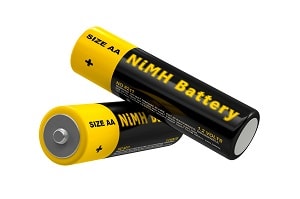
Standard NiMH batteries (as opposed to the newer LSD ones) aren’t designed to be stored for a long time. They drain quickly even when not in use, and if allowed to drain too much, they will be permanently destroyed. Here’s how to keep them working.
Recharge Every 1-2 Months
Standard NiMH batteries have an insanely high self-discharge rate, which means they drain even when sitting idle.
The numbers vary, but generally, you can expect that a NiMH battery will lose 20% of its charge within 24 hours and 10% each month after that. That means that within 8 months, the battery will be completely drained. At high temperatures, the battery will drain even faster.
Don’t Let NiMH Batteries Drain Completely
NiMH batteries don’t have a memory like NiCad batteries do, so there’s no need to drain them completely before recharging. You shouldn’t let them drain completely.
If the battery is allowed to drain too much, it can go past the recovery point. This is why you need to recharge them every 1 to 2 months. The more you use and recharge a NiMH battery, the longer it will last.
Store Charged
Some batteries (including NiMH LSB and Li-Ion) shouldn’t be stored when they are completely full. They discharge faster when fully charged. It’s unclear whether this applies to standard NiMH batteries or not.
However, because NiMH batteries discharge so quickly, they should never be stored while near empty because they could discharge beyond the recovery point.
Keep Cool
NiMH batteries can withstand temperatures of -4F to 95F. However, it’s best to keep them cool (around 40-60F). If the NiMH battery is stored at high temperatures, the rate at which self-discharge occurs will be accelerated.
How much?
At 70F, they will lose up to 40% of their charge in a month! Additionally, the longer the storage period, the more the cell capacity decreases.
Use a Good Battery Charger
NiMH batteries are susceptible to overcharging and overheating. Prevent this from happening by investing in a good battery charger. This will help you get the most lifespan out of the batteries.
Conditioning NiMH Batteries
Sometimes NIMH batteries can suffer from voltage depletion. This occurs when older batteries have been charged many times, and crystals start forming in them. You can revive the batteries with a process called “conditioning.” Some battery chargers will have a conditioning setting.
NiMH LSD Batteries
Maximum Shelf Life: Up to 10 years
Charge Cycles: 500-2,000
Ideal Temperature: 40-60F
Charge Level for Storage: 40%
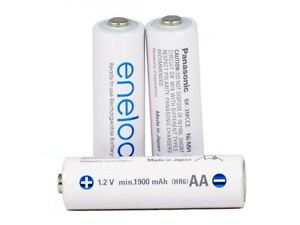
NiMH LSD (low self-discharge) is the newer alternative to standard NiMh batteries. They don’t have high self-discharge like standard NiMH batteries and are suitable for long-term storage. This is what we recommend for disaster prepping.
Store at 40% Charge
Some batteries have a weird behavior: if you store them while full, they start to self-discharge rapidly. However, if they are stored at 40%, they somehow know to “sleep,” and their self-discharge slows drastically.
This applies to NiMH LSD batteries. When stored at 40%, they will retain 70% of their charge after 5 years. If stored at 100%, they might go near dead within a year.
Choose Lower Capacity for More Life Cycles
Another weird feature of NiMH LSD batteries is that high-capacity ones get fewer cycles. For example, a 2500mAh battery might get 500 charging cycles, whereas a 2100mAh battery could get 2,100 cycles.
Li-Ion Batteries
Maximum Shelf Life: 2-3 years
Charge Cycles: 500-1,000
Ideal Temperature: 32-77F
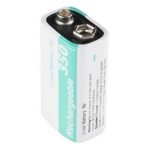
Lithium-ion batteries are great for electronics or devices with high energy requirements that get used daily. However, Li-ion batteries are not suited for long-term storage. They quickly lose their charges and can go beyond the recoverable level.
If you do need to store lithium-ion rechargeable batteries, make sure to follow these guidelines.
Don’t Let Charge Fall Below 20%
When the charge of a Li-ion battery falls below 20%, it can enter sleep mode. After entering this mode, it might never recover and be able to charge normally.
So, be sure to charge your li-ion batteries frequently. If not in use, recharge often so the battery charge doesn’t drain too much from self-discharge.
Store at 40% Charge
Like NiMH LSD batteries, li-ion batteries should be stored at 40% full. If stored when empty, they can self-discharge beyond the point of recovery, meaning they will be completely ruined.
On the flip side, you also shouldn’t store them completely full either. They actually self-discharge faster. When full. Some of this capacity will NOT be recoverable (meaning the battery will never get its total capacity back).
Recoverable Capacity of Li-Ion Batteries after 1 Month of Storage
| Temperature | 40% Charge | 100% Charge |
|---|---|---|
| 32F | 98% | 94% |
| 77F | 96% | 80% |
| 104F | 85% | 65% |
Store at Cool Temperatures
Like any battery, li-ion batteries should be stored at a cool temperature. However, they can be susceptible to heat. The table above shows that they will permanently lose some of their capacity when stored at high temperatures.
Likewise, higher temperatures increase the discharge rate, as shown in the table below. Remember, if a li-ion battery gets completely drained, it can go past the point of recovery.
Self-Discharge Per Month at Various Temperatures
| Temperature | 40% Charge | 100% Charge |
|---|---|---|
| 32F | 2% | 6% |
| 77F | 4% | 20% |
| 140F | 15% | 35% |
Never Let Li-Ion Batteries Get above 140F
Li-ion batteries can EXPLODE or CATCH FIRE if stored in high temperatures. That means they should never be left in your car on hot days, nor in places like your garage.
Check Date When Buying Li-Ion Batteries
Even when stored properly, li-ion batteries only have a shelf life of around 2-3 years. So, if you buy Li-ion batteries that have been sitting around on the manufacturer’s shelf for a while, you have already lost some of their usable life.
Lithium Batteries (Including button cell batteries)
Maximum Shelf Life: Up to 20 years
Ideal Temperature: 60F
Charge Level for Storage: 40%
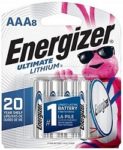
Lithium batteries aren’t rechargeable, but they have the benefit of very low self-discharge rates of just 1-2% per year. After 15 years, they can retain 85% of their charge. This makes them suitable for long-term storage, assuming you store them properly.
Keep Cool
Even though lithium batteries can handle extreme temperatures well, high temperatures will still cause them to self-discharge faster. Ideally, you should keep them at 60F or below.
Don’t Put in the Freezer
While keeping lithium batteries at very cold temperatures will, in theory, help them last longer, the benefit is negligible. However, the risk of them getting wet or condensation is high. So, it’s not worth it to put lithium batteries in the freezer. If your home is hot or humid, refrigerate them in a vapor-proof container instead.
Buy from Reputable Sources
Lithium primary batteries are expensive, so you might be tempted to buy cheap lithium batteries from generic sellers (like those in China). The problem is that these batteries are often sub-par quality, old, or stored in hot warehouses.
It’s not worth it to buy cheap lithium batteries. Make sure you are getting batteries that you can rely on. Only buy from reputable brands and sellers; check the manufacturing date when you purchase.
Alkaline Batteries
Maximum Shelf Life: 5-7 years
Ideal Temperature: 70F
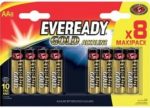
Are you still using alkaline batteries? While they may be the cheapest in the short term, alkaline batteries are an inferior choice. They have a very short lifespan and cost much in the long run.
Alkaline batteries are also very sensitive, so you’ve got to take care to store them properly. Here’s what to keep in mind:
Don’t Leave Them in Devices:
Leakage is a considerable problem with alkaline batteries. If you leave them in devices for a long time, the battery will leak (causing that crystal-like coating on everything). The leaked acid can short the device.
Keep At 70F
Alkaline batteries are very sensitive to heat. Ideally, they should be kept at 70F. At this temperature, they will lose about 2-3% of their charge per year. At 100F, they will lose about 25% of their charge each year.
NiCad Batteries
Maximum Shelf Life: 3-5 years
Ideal Temperature: 70F
Charge Level for Storage: Close to 0%
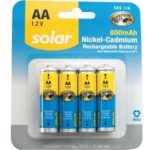
NiCad batteries are also becoming obsolete because of their very high self-discharge rate and poor performance. If you still have these, then be sure to follow these storage guidelines.
Never Short NiCad Batteries
You shouldn’t short any battery, but it can be hazardous with NiCad batteries. They contain toxic cadmium inside them. When the battery ends touch metal, the batteries can explode and send all that toxic material everywhere.
Higher Temperature Increases Self-Discharge
NiCad batteries already have a high self-discharge rate of about 10% per month at around 70F; if you increase the temperature even slightly, the discharge rate skyrockets.
Memory Effect – Empty before Recharging or Storing
NiCad batteries are the only rechargeables that still suffer from the “memory effect.” If you try to recharge them when they are half full, they will “remember” the previous discharge amount and wouldn’t give more than that.
You must discharge them completely before recharging. It’s also recommended to empty them before storage.
Recharge Frequently – Not for Long-Term Storage
NiCad batteries can form crystals inside them when stored for an extended period. This permanently damages the batteries, and they will have to be thrown away.
Because of this issue, NiCad batteries are not suitable for long-term storage. They must be recharged and used frequently if you want them to last their full lifespan.

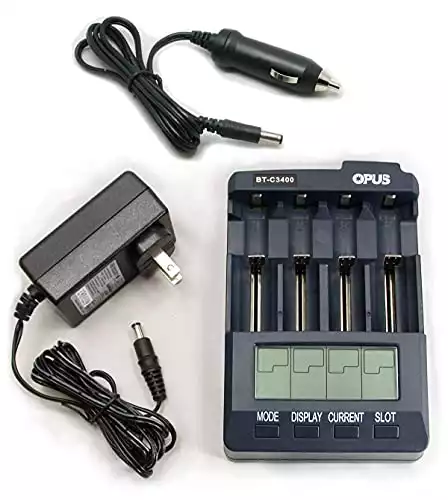


Every on gives advice of safe storage of batteries but where is a cool dry place in a house. All the rooms have windows and bathroom & Kitchen has moisture. Where is a good cool, dry, non moisture place> In the closet or drawers? Frustrated 51yr old.
Mine are in my bedroom. You are right, there is no perfect place in the home for batteries — especially if you live somewhere that gets hot and humid. Basically, you have to make peace with the fact that your batteries will have a shorter shelf life (unless you constantly run your AC when it gets hot, which I don’t).
I have purchased eneloop NiMH LSD AA and AAA batteries as well as the Energizer Ultimate Lithium AA and AAA batteries for long term storage. I see that you recommend to store both kinds of batteries at 40% capacity in order to achieve the longest shelf life possible, but I unsure how to bring the batteries down to a 40% capacity. Can I use the Opus battery charger you recommend in this review to discharge the batteries to this optimal 40% capacity? Also, because the Energizer Lithium batteries are not rechargeable, I will never get that 60% charge back, so does it really make sense to discharge these?
Thank you for your very detailed and informative article!
Don’t discharge non-rechargable lithium batteries.
Yes, you will need a good charger so you know when the batteries are at 40% capacity. The Opus one recommended will display the charge level for each batttery.
Note that I don’t bother with the 40% rule for batteries which I use frequently. The recommendation is for batteries that you will put in storage to have in case of emergencies. Obviously, you’ll also need a way to recharge those batteries during an emergency too, such as a solar charger.
GODS! There’s about a billion things to know and split hairs about to use and store batteries, optimally. It’s not worth it. They should just price all batteries as low as possible so the user can afford to just take the quick and dirty approach instead of going nuts over all that stuff.